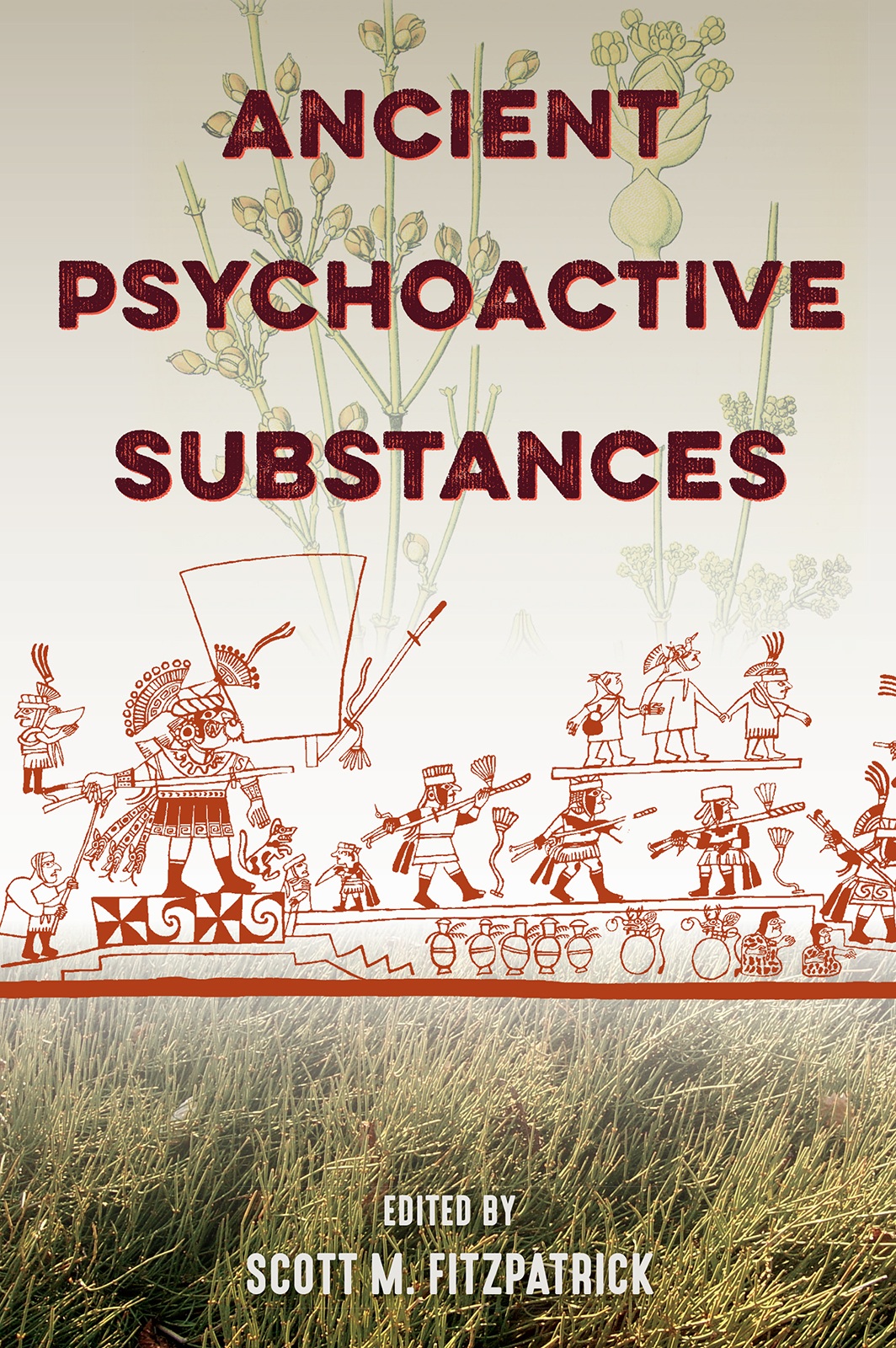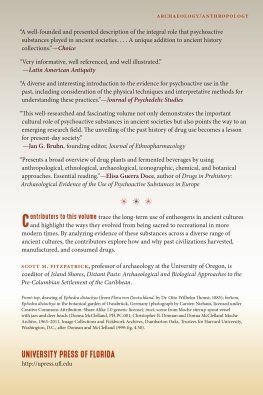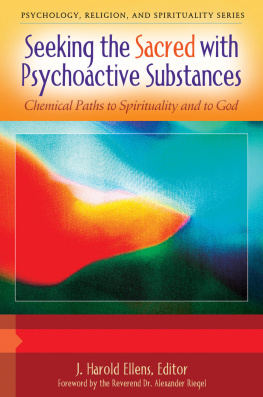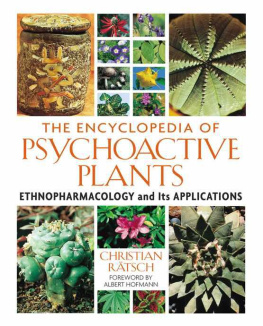Contents
Guide
Page List


Ancient Psychoactive Substances


UNIVERSITY PRESS OF FLORIDA
Florida A&M University, Tallahassee
Florida Atlantic University, Boca Raton
Florida Gulf Coast University, Ft. Myers
Florida International University, Miami
Florida State University, Tallahassee
New College of Florida, Sarasota
University of Central Florida, Orlando
University of Florida, Gainesville
University of North Florida, Jacksonville
University of South Florida, Tampa
University of West Florida, Pensacola
ANCIENT
PSYCHOACTIVE
SUBSTANCES

Edited by
SCOTT M. FITZPATRICK
UNIVERSITY PRESS OF FLORIDA
Gainesville . Tallahassee . Tampa . Boca Raton
Pensacola . Orlando . Miami . Jacksonville . Ft. Myers . Sarasota
Copyright 2018 by Scott M. Fitzpatrick
All rights reserved
Published in the United States of America
This book may be available in an electronic edition.
First cloth printing, 2018
First paperback printing, 2020
25 24 23 22 21 20 6 5 4 3 2 1
Library of Congress Cataloging-in-Publication Data
Names: Fitzpatrick, Scott M., editor.
Title: Ancient psychoactive substances / edited by Scott M. Fitzpatrick.
Description: Gainesville : University Press of Florida, 2018. | Includes bibliographical references and index.
Identifiers: LCCN 2017032192 | ISBN 9780813056708 (cloth : alk. paper)
ISBN 9780813068183 (pbk.)
Subjects: LCSH: Psychotropic drugsHistory. | Hallucinogenic drugsHistory. | Altered states of consciousnessHistory. | Hallucinogenic drugs and religious experienceHistory. | Drug abuseHistory. | AlcoholismHistory.
Classification: LCC RM315 .A58 2018 | DDC 615.7/883dc23
LC record available at https://lccn.loc.gov/2017032192
The University Press of Florida is the scholarly publishing agency for the State University System of Florida, comprising Florida A&M University, Florida Atlantic University, Florida Gulf Coast University, Florida International University, Florida State University, New College of Florida, University of Central Florida, University of Florida, University of North Florida, University of South Florida, and University of West Florida.
University Press of Florida
2046 NE Waldo Road
Suite 2100
Gainesville, FL 32609
http://upress.ufl.edu

CONTENTS
vii
xi
Scott M. Fitzpatrick and Mark D. Merlin
Mark D. Merlin and Robert C. Clarke
Zuzana Chovanec
Mark D. Merlin
Sean M. Rafferty
Victor D. Thompson and Thomas J. Pluckhahn
Quetta Kaye
Daniel M. Seinfeld
Jennifer Loughmiller-Cardinal
Constantino Manuel Torres
Matthew P. Sayre
Justin Jennings and Lidio M. Valdez
ILLUSTRATIONS
TABLE
FIGURES
ACKNOWLEDGMENTS
I thank each of the authors for their extraordinary patience as the volume came together over the past few years. Matthew Napolitano deserves special recognition for helping to format the text, produce or modify figures used in the book, and tie up various loose ends. Mark Merlin, one of the worlds leading authorities on a number of psychoactive substances and the author or coauthor of three chapters in this book, was especially helpful in clarifying many issues that arose and has become a welcome and inspiring colleague. Special recognition goes to Meredith Babb at the University Press of Florida for guiding the volume through the various stages of review and production. And to my family and friends for their long-term support of this and other research-related activities that have occasionally taken much longer than expected. Finally, I would like to acknowledge my uncle, David Fitzpatrick, who benefitted greatly in the last years of his life from the Oregon Medical Marijuana Program to alleviate suffering from brain cancer and related treatments. This initiative and many others like it are positively affecting thousands of lives. They are also a strong testament to the need for conducting further scientific inquiry into the wide array of psychoactive substances known worldwide so that their medicinal, nutritional, mind-altering, and other properties can be more thoroughly investigated and understood. As this volume clearly illustrates, the effects and benefits of entheogensrecognized by our ancestors millennia agocontinue to dramatically structure and influence our daily lives.
Introduction
Drugs from a Deep Time Perspective
SCOTT M. FITZPATRICK AND MARK D. MERLIN
It is often said that history repeats itself and that necessity is the mother of invention. While these two well-known maxims could equally apply to any number of contexts and situations across space and time, we would argue that they are perhaps at their most appropriate when describing the need for humans on a global scale to alter their reality. More often than not, this is achieved through the use of psychoactive substances.
The term psychoactive can be defined as of or pertaining to a substance having a profound or significant effect on mental processes. Broadly construed, this covers a range of compounds found in an enormous variety of different biological organisms that alter perceptions of the user. The widespread use of legal (e.g., coffee, tea, betel nuts, tobacco, alcohol) and illicit drugs (e.g., heroin, cocaine, many hallucinogens) in modern society, and the subsequent problems they can create, is a strong testament to how pervasive and sometimes dangerous it is for humans to seek out and succumb to the vagaries of both natural and synthetic substances. It is a near-universal phenomenon and one that many have argued has roots that extend deep into our ancient evolutionary past (Clarke and Merlin 2013; Dobkin 1990; Furst 1972; Guzmn 1983; Merlin 1984, 2003; Schultes and Hofmann 1980; Schultes et al. 2001; Torres 1999, 2001).
There are many different types of psychoactive substances that are often grouped into four major categories: inebriants (e.g., alcohol), stimulants (e.g., betel nuts, caffeine, nicotine, cocaine, ephedrine), opiates and other narcotics (e.g., opium and its derivatives, such as heroin), and hallucinogens (e.g., mescaline, psilocybin, and synthetics such as LSD). Many of the known, naturally occurring psychoactive substances produced by certain flowering plants and fungi, which can cause alteration in perception, cognition, and mood as [their] primary psychobiological actions in the presence of an otherwise clear sensorium (Abraham et al. 1996: 287), have often been classified as hallucinogenic species. However, their potent, mind-altering plant substances generally do not produce dependence or become addictive (Nicols 2004: 131). In recent decades, these substances have been the focus of abundant research in the social and natural sciences (e.g., Brawley and Duffield 1972; Clarke and Merlin 2013; Devereux 1997; Dobkin de Rios 1990; Grinspoon and Bakalar 1979; Lee and Roth 2012; Martin and Sloan 1977; Merlin 2003; Nicols 2004; Rivier 1994; Sankar 1975; Schultes and Hofmann 1980; Schultes et al. 2001; Siegel 1989; Strassman 1984; Torres 2001). Most of these mind-altering substances are bitter alkaloids, which seem to have evolved naturally as defense mechanisms against herbivores (e.g., see Abraham et al. 1996: 28586).










 Ancient Psychoactive Substances
Ancient Psychoactive Substances 


